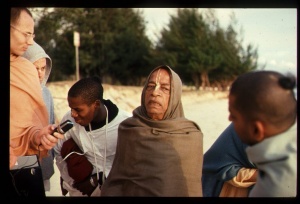SB 12.11.47-48: Difference between revisions
m (1 revision(s)) |
No edit summary |
||
| Line 1: | Line 1: | ||
{{info | {{info | ||
|speaker= | |speaker=Sūta Gosvāmī | ||
|listener=Sages of | |listener=Sages of Naimiṣāraṇya | ||
}} | }} | ||
[[Category:Srimad-Bhagavatam - Canto 12 Chapter 11]] | |||
[[Category:Bhagavatam Verses Spoken by Suta Gosvami - Vanisource|121147]] | |||
<div style="float:left">'''[[Srimad-Bhagavatam]] - [[SB 12.11: Summary Description of the Mahapurusa|Chapter 11: Summary Description of the Mahāpuruṣa]]'''</div> | |||
<div style="float:right">[[File:Go-previous.png|link=SB 12.11.46]] '''[[SB 12.11.46]] - [[SB 12.11.49]]''' [[File:Go-next.png|link=SB 12.11.49]]</div> | |||
{{RandomImage}} | |||
{{SBnotice}} | |||
==== TEXTS 47-48 ==== | ==== TEXTS 47-48 ==== | ||
<div | <div class="verse"> | ||
sāmarg-yajurbhis tal-liṅgair | :sāmarg-yajurbhis tal-liṅgair | ||
ṛṣayaḥ saṁstuvanty amum | :ṛṣayaḥ saṁstuvanty amum | ||
gandharvās taṁ pragāyanti | :gandharvās taṁ pragāyanti | ||
nṛtyanty apsaraso 'grataḥ | :nṛtyanty apsaraso 'grataḥ | ||
unnahyanti rathaṁ nāgā | |||
grāmaṇyo ratha-yojakāḥ | :unnahyanti rathaṁ nāgā | ||
codayanti rathaṁ pṛṣṭhe | :grāmaṇyo ratha-yojakāḥ | ||
nairṛtā bala-śālinaḥ | :codayanti rathaṁ pṛṣṭhe | ||
:nairṛtā bala-śālinaḥ | |||
</div> | </div> | ||
| Line 21: | Line 27: | ||
==== SYNONYMS ==== | ==== SYNONYMS ==== | ||
<div | <div class="synonyms"> | ||
sāma-ṛk-yajurbhiḥ—with the hymns of the Sāma, Ṛg and Yajur Vedas; tat-liṅgaiḥ—which reveal the sun; ṛṣayaḥ—the sages; saṁstuvanti—glorify; amum—him; gandharvāḥ—the Gandharvas; tam—about him; pragāyanti—sing loudly; nṛtyanti—dance; apsarasaḥ—the Apsarās; agrataḥ—in front; unnahyanti—bind up; ratham—the chariot; nāgāḥ—the Nāgas; grāmaṇyaḥ—the Yakṣas; ratha-yojakāḥ—those who harness the horses to the chariot; codayanti—drive; ratham—the chariot; pṛṣṭhe—from the rear; nairṛtāḥ—the Rākṣasas; bala-śālinaḥ—strong. | sāma-ṛk-yajurbhiḥ—with the hymns of the ''Sāma'', ''Ṛg'' and ''Yajur Vedas''; tat-liṅgaiḥ—which reveal the sun; ṛṣayaḥ—the sages; saṁstuvanti—glorify; amum—him; gandharvāḥ—the Gandharvas; tam—about him; pragāyanti—sing loudly; nṛtyanti—dance; apsarasaḥ—the Apsarās; agrataḥ—in front; unnahyanti—bind up; ratham—the chariot; nāgāḥ—the Nāgas; grāmaṇyaḥ—the Yakṣas; ratha-yojakāḥ—those who harness the horses to the chariot; codayanti—drive; ratham—the chariot; pṛṣṭhe—from the rear; nairṛtāḥ—the Rākṣasas; bala-śālinaḥ—strong. | ||
</div> | </div> | ||
{{SBcollapse}} | |||
==== TRANSLATION ==== | ==== TRANSLATION ==== | ||
<div | <div class="translation"> | ||
While the sages glorify the sun-god with the hymns of the Sāma, Ṛg and Yajur Vedas, which reveal his identity, the Gandharvas also sing his praises and the Apsarās dance before his chariot. The Nāgas arrange the chariot ropes and the Yakṣas harness the horses to the chariot, while the powerful Rākṣasas push from behind. | While the sages glorify the sun-god with the hymns of the Sāma, Ṛg and Yajur Vedas, which reveal his identity, the Gandharvas also sing his praises and the Apsarās dance before his chariot. The Nāgas arrange the chariot ropes and the Yakṣas harness the horses to the chariot, while the powerful Rākṣasas push from behind. | ||
</div> | </div> | ||
__NOTOC__ | </div> | ||
</div> | |||
<div style="float:right">[[File:Go-previous.png|link=SB 12.11.46]] '''[[SB 12.11.46]] - [[SB 12.11.49]]''' [[File:Go-next.png|link=SB 12.11.49]]</div> | |||
__NOTOC__ | |||
__NOEDITSECTION__ | |||
Revision as of 06:39, 1 July 2021

A.C. Bhaktivedanta Swami Prabhupada
Please note: The synonyms, translation and purport of this verse were composed by disciples of Śrīla Prabhupāda
TEXTS 47-48
- sāmarg-yajurbhis tal-liṅgair
- ṛṣayaḥ saṁstuvanty amum
- gandharvās taṁ pragāyanti
- nṛtyanty apsaraso 'grataḥ
- unnahyanti rathaṁ nāgā
- grāmaṇyo ratha-yojakāḥ
- codayanti rathaṁ pṛṣṭhe
- nairṛtā bala-śālinaḥ
SYNONYMS
sāma-ṛk-yajurbhiḥ—with the hymns of the Sāma, Ṛg and Yajur Vedas; tat-liṅgaiḥ—which reveal the sun; ṛṣayaḥ—the sages; saṁstuvanti—glorify; amum—him; gandharvāḥ—the Gandharvas; tam—about him; pragāyanti—sing loudly; nṛtyanti—dance; apsarasaḥ—the Apsarās; agrataḥ—in front; unnahyanti—bind up; ratham—the chariot; nāgāḥ—the Nāgas; grāmaṇyaḥ—the Yakṣas; ratha-yojakāḥ—those who harness the horses to the chariot; codayanti—drive; ratham—the chariot; pṛṣṭhe—from the rear; nairṛtāḥ—the Rākṣasas; bala-śālinaḥ—strong.
Translation and purport composed by disciples of Śrīla Prabhupāda
TRANSLATION
While the sages glorify the sun-god with the hymns of the Sāma, Ṛg and Yajur Vedas, which reveal his identity, the Gandharvas also sing his praises and the Apsarās dance before his chariot. The Nāgas arrange the chariot ropes and the Yakṣas harness the horses to the chariot, while the powerful Rākṣasas push from behind.